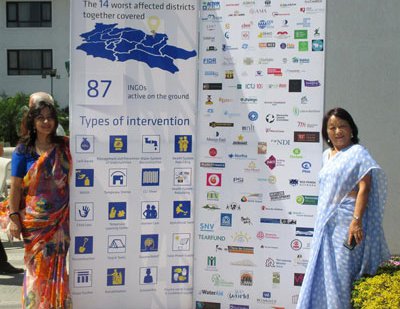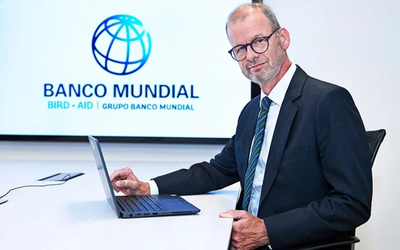
Specialized in various sectors of disasters, INGOs, although they did not receive all the needed facilitation from the government, provided humanitarian support, reaching the remote parts of Nepal to serve the poor and vulnerable communities. Mobilizing over 200 million dollars, members of Association of International NGO, AIN, have been in the forefront in the rescues, relief and rehabilitation operations over the three months since the killer earthquake of April 2015
“We have been to villages that have not seen any medical care. Our presence shows to the people that others out here care about what happened to them,” said Kevin Murphy, volunteer nurse at International Medical Corps.
Karuna Foundation supported a number of families with physical disabilities to build transitional shelters in Bhaktapur and Rasuwa. After the completion of early phase of relief, Practical Action is now conducting training to local masons on how to build earthquake resilient houses. VSO collaborated with Save the Children and mobilized volunteers with effective coordination. Restless Development responded through the mobilization of youth.
These are not exceptions. Out of 116 AIN members, 87 INGOs reached the villages to respond to the earthquake victims with a package or two of long term and short term relief.
As a volunteer of International Medical Corps, Murphy said after Nepal’s security forces and communities, INGOs were the first to reach the earthquake devastated areas with rescue experts and relief materials, including medicines, foods and temporary shelters in the remote parts of Nepal.
Even after the closure of the rescue relief mission, Nepal based INGOs continue to be present in the remote areas with relief materials and help people build transitional shelters.
With the coordination of District Disaster Relief Committees, members of AIN are carrying out the work in earthquake devastated areas. In the last three months, AIN members have already spent over 200 million dollars. As the reconstruction phase is more difficult and complex, it requires more resources as well as expertise.
Three months after the devastating earthquake of April 25 and a number of aftershocks, Nepal is gradually recovering from the trauma and people are coming back to normal life. As organizations working directly in the community level, INGOs too played important role to build confidence among poor and marginalized communities, living in remote parts of Nepal.
As soon as the government called on the international community for support to cope with the devastating earthquake on April 26, INGOs mobilized their workforce responding to the government call.
“We are happy to say that INGOs spared no time to respond to our call and all INGOs marched to earthquake devastated areas with the available resources and materials,” said Rabindra Kumar, member secretary of Social Welfare Council. “We appreciate their support in carrying out the relief operation in remote parts of Nepal. They helped to save the lives of hundreds of needy people.”
With their expertise on various disaster management and livelihood schemes, AIN members responded to the government’s emergency call and mobilized their institutions to provide relief materials to the people.
Although INGOs working in Nepal played an important role in rescue and relief operations, saving hundreds of people, they have not received the response they deserved.
Finance minister issued a guidance announcing a new measure which restricts INGOs in fund mobilization and SWC’s recent announcement is also likely to create obstructions.
“As the first phase is over now, INGOs will now have to come with new proposals for the reconstruction phase,” Member Secretary Rabindra Kumar told New Spotlight. “They need fresh approval for another phase.”
Knowingly and unknowingly, authorities are taking restrictive steps towards the INGOs. As Nepal has to go for a long march in the reconstruction phase and the role of INGOs will be more effective and their expertise needs to be used. However, the government and Social Welfare Council, in their recent moves, directed the INGOs and NGOs in a way that might affect thelong term recovery.
As forefront organizations working in the community level with poor and marginalized population, imposing conditions for INGOs will affect the program directed to poor who suffered most in the last earthquake.
According to a report, 2.8 million people are still in need of humanitarian assistance, including an estimated 864,000 people living in remote villages. Some 1.1 million people have been left without long-term access to protected water sources,100,000 people still live in open air sites and hundreds and thousands are still in makeshift shelters. There is the need to reconstruct 446 health facilities, 10,000 school buildings and 30,000 classrooms.
Nepal’s government and big donors alone cannot complete this mammoth task. With the absence of elected representatives, NGOs and INGOs can fill the gaps given the effective coordination from district government offices.
With a network of 116 INGOs working in Nepal, Association of International NGOs in Nepal (AIN) members have been supporting a wide-range of issues and sectors in Nepal’s development efforts.
Given the past experiences, INGOs and their partners have contributed to bring transformative change in people's lives in many sectors, including education, health, water and sanitation, environment, disaster management and livelihoods.
“SWC has already acknowledged the fact that INGOs and NGOs were quick to reach the disaster areas along with packages. Social Welfare Council highly appreciates the effective humanitarian role played by INGOs during the first phase of rescue and relief operation. The government is also grateful to their efforts,” said Rabindra Kumar, member secretary of Social Welfare Council.
Depending on their specialized areas, INGOs have contributed from food to shelter, water to health, child protections to disaster management, temporary shelter to taking care of persons with disability and Leprosy patients. They also launched programs on anti-trafficking, transitional shelter, water disinfection drop, hygiene and sanitation.
One can see the visible presence of INGOs in the district level. “We are supporting the recovery plan,” said Govinda Neupane, country director, Swedish Development Partner.
As INGOs completed over three months of service in earthquake hit area, AIN organized an event to mark the three months with the first earthquake exhibition and interaction to show INGOs contribution and role in post earthquake Relief and Reconstruction in Nepal.
“INGOs reached all remote parts of Nepal to provide humanitarian assistance to the needy people. We have spent 200 million dollars equivalent of relief materials and temporary shelters and rescue and relief missions,” said Sarah Blin, AIN vice chair and country director, Handicap International. She said that INGOs should be given clear direction so that they can work more effectively in the coming reconstruction phase.
Nepal achieved tremendous success in rescue and relief missions in three months and the contribution made by INGOs was immense. This was what one would see in the AIN Exhibition and Interaction Program.
“INGOs are working alongside the Nepal government. Members of AIN are working under the coordination with the District Relief Committee (DDRC) to ensure faster and better delivery of aid. This underscores the government’s confidence in AIN members. AIN will continue responding to needs of the community as reflected in the Post Disaster Needs Assessment report developed by donors and government,” said Rajendra Mulmi, AIN chair and country director of Search for Common Ground. “The cost of relief and recovery carried out by the AIN member INGOs adds up to approximately USD 200 million.”
Out of 116 members of AIN, 87 INGOs showcased the scale and nature of the response in areas such as food and non-food distribution, injury rehabilitation, emergency healthcare, emergency education, shelter, livelihoods, water and sanitation, in all 14 priority districts and beyond.
Despite such a major contribution in the areas of rescue and relief, the government is yet to call INGOs in the post-earthquake rehabilitation and reconstruction. “We need INGOs involvement. However, the government can take the decision only after evaluating the work done by INGOs,” Rabindra Kumar told New Spotlight.
As a partner of Nepal’s overall development, INGOs brought here expertise in many issues. “We are part of the development process in Nepal supporting local NGOs to carry out development activities directing poor and marginalized communities. INGOs have shown how they can effectively work given proper role in disaster. With the mobilization of the community, we have contributed to the government’s program,” said Dr. Prabin Manandhar, AIN SC member, country director of Lutheran World Federation. “At a time when the government does not have the capability to carry out reconstruction work on its own, they need support of INGOs and NGOs.”
Despite certain lacunas and shortcomings, INGOs and NGOs have successfully shown their effective role in transformation at community level. They have done their part more effectively during the earthquake.
“Our organizations reached the community to provide the emergency relief including the treatment and building transitional shelters,” said Maria Ibragimova, AIN member and country director International Medical Crops.
Along with providing treatment, INGOs also mobilized young Nepalese volunteers in disaster prone areas. “ INGOs provide life-saving support to the people affected by the earthquake and contribute to their long term recovery,” said Ravindra Shakya, AIN treasurer and country director Restless Development.
With the strong local footing, strong ties with community and the global expertise in humanitarian work, INGOs helped speed up the relief to those in need."With the relatively small resources, we were able to reach to the needy community through our local partners and community,” said David Smith, AIN SC member and country director Dan Church Aid.
INGOs have been active providing immediate relief followed by long term rehabilitation work. They have been working in the earthquake-affected districts, in coordination with the District Disaster Management Committees at the district level and in coordination with the relevant ministries and UN through the cluster mechanisms.
Although INGOs are small organizations with limited capacities, they have contributed to bring back the community in the right track. If Nepal pursues the policy to taking INGOs in the reconstruction phase and maintaining resilience of local community, Nepal can recover much faster -- this is the lesson learned from the first three months of the relief and recovery process.

Keshab Poudel
Poudel is the editor of New Spotlight Magazine.
- FOURTH PROFESSOR Y.N. KHANAL LECTURE: Nepal-China Relations
- Jun 23, 2025
- Colonel JP CROSS: Centenary Birthday
- Jun 23, 2025
- REEEP-GREEN: Empowering Communities with MEP
- Jun 16, 2025
- BEEN: Retrofitted For Green
- May 28, 2025
- GGGI has been promoting green growth in Nepal for a decade: Dr. Malle Fofana
- May 21, 2025















